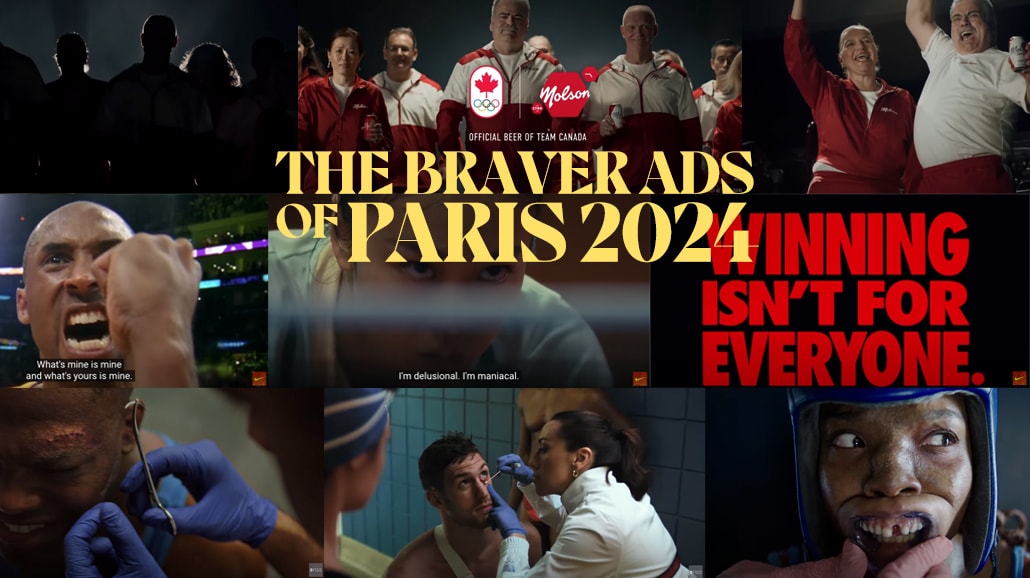The Olympic Ads That Stuck A Braver Landing

The 10, 714 athletes that competed in The Paris 2024 Olympic Games are now back home either celebrating or recovering. Many most likely are already training for their next competitions and setting new goals for Los Angeles 2028. But what about the ad games that played out over the past months leading up to and running through July? Brands from around the world brought their A-Game to the broadcasts and streams of The Paris 2024 Games. Inspirational stories and visuals of Olympic athletes were crafted to promote everything from cars, credit cards , timepieces, fashion, and energy drinks.
Here’s my podium for the bravest ads of this Olympic summer:
My Bronze Medal for Braver Branding goes to FIGS and their agency Mother for “Anatomy of a Champion: Celebrating the USA Medical Team.
FIGS outfitted Team USA’s entire medical corps, 250 people strong, who provided medical care to the athletes at this year’s Games. FIGS believes that this work is “the ultimate team sport.” Masterfully celebrating the gross moments of these caretakers’ jobs (and the moments most likely to make people squeamish), this spot was set to a new version of the “Head, Shoulders, Knees and Toes” song with lyrics tailored to these duties. The creative play on the song created a wonderful juxtaposition with the visuals of the athletes’ injuries and the preventative care they received. With that combination, the brand successfully celebrates the grit of the medical pros outfitted by FIGS who will keep Team USA in the competition. The spot is hard to ignore and dramatizes the commitment of the entire Team USA (support staff included) in a different way than many other advertisers at The Games.
Our Silver Medal goes to Rethink Communications and Molson Canada for “Sponsor The Parents.”
Nine parents of Team Canada athletes were featured in this ad. But the real magic is that the brand treated these parents as if they were sponsored athletes with their Paris 2024 journeys supporting their kids on Molson’s Instagram channel. Plus they were decked out in their own team swag, and of course, their commitment as athletes’ parents was toasted with plenty of ice-cold beer.
I feel this is braver brand work because Molson didn’t play by the expected, dramatic narratives common in many Olympic ads, especially when focused on the relationships between parents and their athlete children. The spot put these athletes’ support systems on a pedestal, but in a distinctly humorous fashion that cut through the packed commercial breaks. Nice job, Molson and Rethink!
My Gold Medal for Branding Ever Braver goes to Nike for their spot, “Am I A Bad Person?”
Nike was born of—and at its best has marinated for decades in—an authentic sports mindset. In this campaign they applied the insight—the human truth—that the character of the fiercest athletic competitors could be construed as selfish, obsessive, deceptive, maniacal and a whole lot more seemingly deplorable attributes. But what’s most interesting to me is that the narrative laying out these negatives, with Willem Dafoe doing voiceover, could easily apply to the divisive nature of today’s cultural and political environment right here in the U.S.
Nike and Wieden+Kennedy were brave to craft the message in this manner. In today’s cultural climate, it was inevitable that many would perceive the company as stirring up a hornet’s nest of division and glorifying questionable human ethics. The public is usually quick to condemn this kind of thing, especially when it involves their sports icons.
But I believe they are simply illustrating what it takes to be a champion at the highest levels of sport where, in fact, “winning isn’t for everyone.” A small percentage of those nearly 11,000 athletes returned home from Paris (or Fiji for the surfers) with medals for their commitment to their sports. These are the ranks of sport where few thrive without the required killer instinct to win among the elite.
And so, in a very real way, Nike is making a statement about our broader cultural climate. It was both nuanced and powerful to apply these traits—so often used to characterize today’s polarizing political and pop culture figures—to the game play of the precious few athletes at the highest levels of sport.
So as marketers, what can we take away from my braver Olympic ad picks?
Humor was leveraged expertly by these brands to create distinctive spots and set them apart from the common narratives about athletic commitment and drive used in marketing during The Games. Humor was most overt in the Molson ad, but the music in the FIGS’ ad counterbalanced the sometimes gory medical situations that were depicted visually. And the exaggeration in Nike’s spot drove home the satirical point about the worst figures in our broader cultural lives.
Several Olympic spots used big celebrities and fancy special effects to create cinematic pieces that wowed audiences. But the spots that resonated most with me used authenticity to drive their messaging. The real situations that athletes and their medical teams deal with to compete at the Olympic level were at the center of the FIGS’ spot. The real parents of real Team Canada athletes were central to Molson’s effort despite the comic approach. And the frankness—while exaggerated to make a more profound cultural statement—of the mental attitudes of that impressive roster of Nike athletes shown in their spot made it powerful beyond an edit of unbelievable athletic prowess.
Thank you FIGS, Molson and Nike for this latest master class in braver branding.

